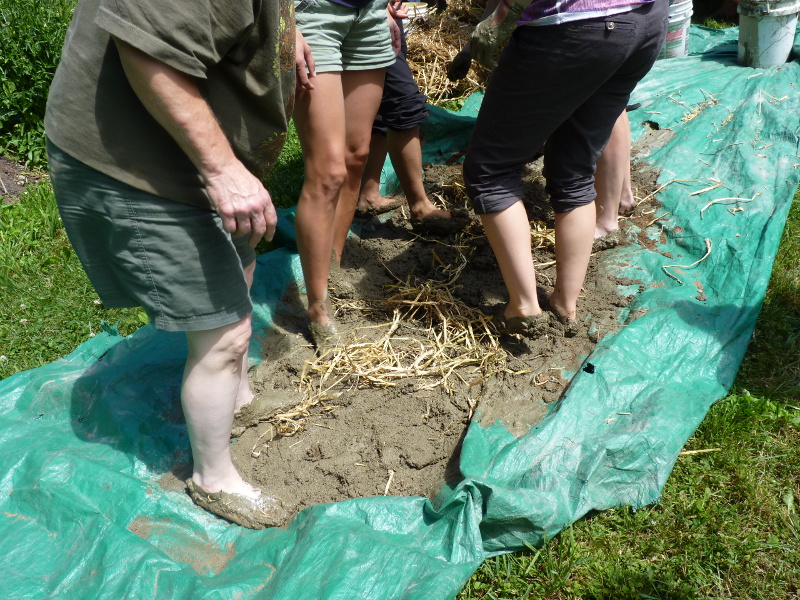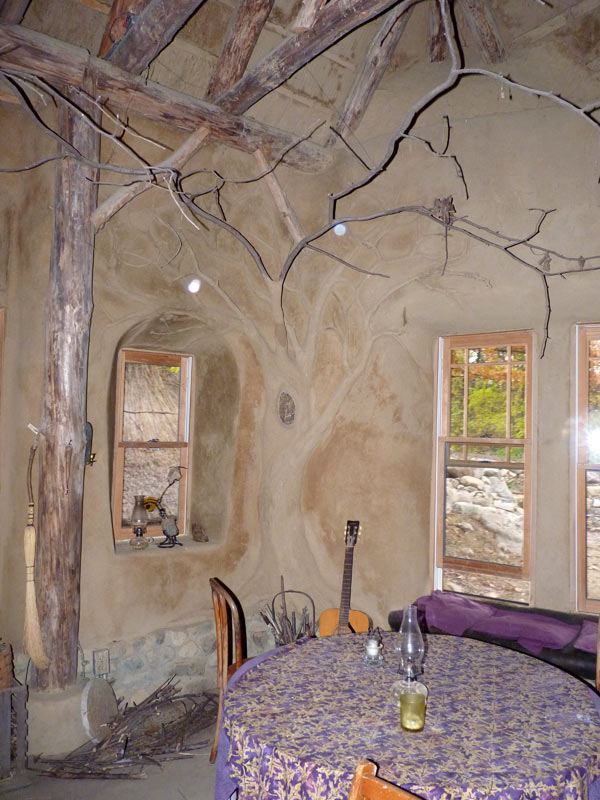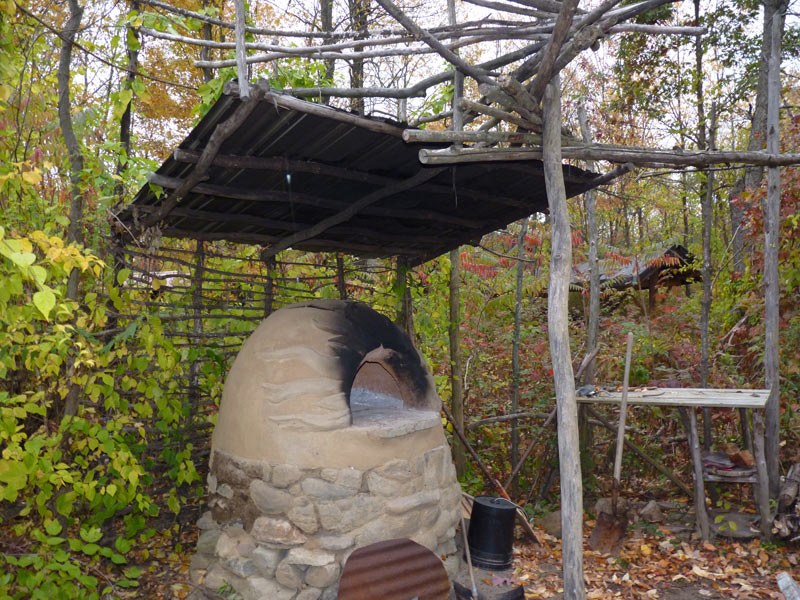
Connecting with the earth can mean a lot of things–and today, I want to talk through how to create a simple building material that can be used for a wide variety of purposes: cob. Cob is an ancient building material that is a combination of sand, clay, and straw (or other strengthening materials) mixed with water. Cob, the synthesis of water and earth, becomes the passive forms through which we shape anything from a small earth oven to a whole living space. In this post, I’ll introduce cob and offer some different kinds of projects that you can do with it. This post compliments last week’s post, where I shared how to make ecobricks from waste plastic materials. Cob is certainly one of the more sustainable and local construction materials to use in conjunction with ecobricks, so I thought it would be a nice time to introduce this as well. I’m also going to be doing a variety of cob projects on the homestead in the next few years that I will share about, and thus, it is useful to have this introduction first!
For many years, when I was studying natural building and various kinds of sustainable living at Strawbale Studio in Michigan, I offered a series of posts on natural building topics and rocket stoves. This post continues that series, and I am delighted to revisit some of these construction techniques. This post will serve as a basic introduction to natural building with cob–for more resources, there are books and classes (I’d highly suggest one of the internships at Strawbale Studio for a hands on experience!) Today’s post covers the preliminaries for cob building – what cob is, the kinds of projects you can make with cob, and the spiritual implications of learning to work with this amazing material. Next week’s post will show you how to test your soil and make cob. Once I finish it in a month or so, I will also show the cob/cobblestone build a simple passive solar greenhouse heatsink wall.
Connecting to the Earth
Cob is the combination of sand, clay, and straw that has been used as a building material throughout the ages. It is a most ancient building material, an ancestral building material. It is always a local resource that reflects the different qualities of the earth in that location. It has been created by humans for thousands of years (if not longer), and is used in a number of building techniques, including adobe construction, waddle and daub construction, strawbale construction, and much more. In fact, nearly every temperate or tropical non-industrial culture has created their own version of cob in some capacity. This is a building material that is right from the land, created with our bodies in perfect harmony with the living earth.
In modern industrialized cultures, we often live in and build structures in opposition to the land. These structures almost always ignore basic things like sunlight, wind, or other weather patterns that would make heating and cooling them more effective and instead, rely on unsustainable fossil fuel burning to make them comfortable. We live in houses full of toxic substances: the materials were toxic to the land and her peoples (human or otherwise) during extraction, toxic during their production, and they will be toxic when they are destroyed and put in a landfill. Our homes, structures, and building materials are thus in a constant state of disconnection from the living earth. I think it’s hard to live that way, even subconsciously, and not experience some disconnection as well.
Cob offers us one path, of many, back to more nature connection. Learning some cobbing and other natural building skills can help us connect with the earth, honor the earth, and learn some of the deeper mysteries of the land. We can reconnect with the wisdom of our ancestors, who built shelters and homes right from the land around them. Learning to make cob, even through small things like making cob candleholders, allows for that deep, ancestral connection. There is nothing as satisfying as communing with the earth, digging up some of her subsoil, sifting it, and stomping it with your bare feet to mix it into something that you can use to create virtually anything! The mud between your toes, the weight of the earth, the shape of it in your hands–it is empowering, it is connective, and it is soul-filled.
Making cob and building with cob (also known as “cobbing”) also offers powerfully to the druid elements (which are explained here): particularly, the synthesis of gwyar and calas. You can also think of cob through the classical elements: the passive elements of water and earth are combined to build structures that heat, shelter, and allow us to cook meals, and so on. It is an incredible and beautiful way to learn to live more in harmony with nature.
In the 21st century and the age of the Anthropocene, I think we need multiple pathways to find our way back to the cradle of the earth. To a place of connection, or re-connection. Of learning that the earth, right under our feet, and the living things around us can truly provide all of our basic necessities for life. This is a lesson that humanity has forgotten in the century+ past industrialization, but it is time that we begin to learn this lesson anew. And for some of us, this lesson comes in the form of learning to build as our ancestors did–of using materials right from our land.
What are the benefits of working with Cob?

Local and sustainable sourcing, ethical building material. Because cob is locally sourced, it is an extremely sustainable building material. If you have the right kind of sub-soil, you can literally dig it out of your land and make it right there. Some sub-soil may require off-site amendments, depending on the nature of your soil (see soil tests, next week’s post). Cob comes right from the earth, and can return right to the earth, with minimal to no ecological impact. For example, in digging my hugelkultur beds, I replaced hard-packed clay with large amounts of wood, plant matter, and compost–and the clay that was removed from those beds was piled up nearby, ready to be turned into cob. Now I have a giant pile of subsoil that I am slowly using for new cob projects
By comparison, modern construction materials are just awful from an environmental perspective. For example, the production of concrete is the *third largest* producer of C02 in the world! The link in the last sentence shows at how many different stages the production of concrete is linked to C02. Yes, concrete is more permanent than cob, but it comes with serious disadvantages.
Endless possibilities for construction. The possibilities of building with cob are endless! You can build earth ovens, chicken coops, candleholders, and even whole living structures. About 10 years ago, strawbale/cob construction was listed in the International Building Code, which makes it easier to secure the necessary permits in places that require them. Most of the “finished” photos in this post are from the Strawbale Studio, built by my natural building mentor, Deanne Bednar. In addition, unlike many conventional building materials that require squares and rectangles, cob also allows for amazing amounts of versatility and creativity. Unlike regular structures built with straight lines, cob allows for flowing curves, circles, spirals, and many unique features. Thus, many natural building projects are flowing, curvy, and fun.
Accessible to everyone. If you didn’t grow up “handy” or had someone to teach you, traditional construction may be inaccessible–both because it requires a lot of specialized knowledge and also because it requires multiple kinds of expensive tools and supplies. By comparison, cob construction can be taught to anyone, including children. In fact, cob allows us to build things right from the land, on the land, with minimal hand tools and no fossil fuel demands. It is perfect for group settings, schools, and other places where people want to join together to do something fun.

Building with cob is “slow” and “meditative.” Taking fossil fuels out of the equation requires a different kind of time commitment. Fossil fuels allow us to radically increase the speed at which things are done, but not the quality by which they are done. Cobbing allows us to slow down, to re-attune with earth’s rhythms, and to have fun making something magical with our own hands and feet! This is “earth time” and requires us to simply embrace the experience. Creating and working with cob is not done on “fast time” but represents a very slow and meditative process. I list this as a benefit because I truly believe it to be so–by attuning with the earth and her building materials, we are forced to slow down, breathe, and be a participant in the process.
Can be combined with other sustainable practices. Cob is but one of many different techniques that can be used to build material. Timber framing, ecobricks, thatching, passive solar, rocket stoves/energy-efficient heating, and shingle making from wood are just some of the strategies that align with these approaches. A rich universe of knowledge awaits you down this path!
Example Cob Projects: Rocket Stoves, Ovens, and Structures
One of the first considerations when thinking about a cob building project is matching the cob project to your climate. In arid climates where there is little rain, cob can be out in the sun and elements unprotected with minimal damage. In a temperate climates with lots of rain, sleet, hail, and snow, special considerations are needed to protect the cob from the elements. In particular, cob designs need to have a “good hat” and “good feet.” That is cob projects are required to have some kind of protective structure that prevents the cob from getting wet–even with a finish plaster, it cannot stand up to the regular elements for extended periods. A good footer, usually made of stone, is what you rest cob on (so that it can’t wash away). This is one of the big differences between concrete and cob. Concrete is designed to stand up to the elements for years–but it also means that it will not return easily to the earth. Cob requires more TLC with regards to the elements but is perfectly fine when designed correctly. As you see some of the examples of cob projects, you will see the use of the good hat/good foot design! With this in mind, let’s explore some of the wonderful projects you can do with Cob!
Cob Ovens for Pizza and Baking. A staple in the cob world and a project that can be completed over several weekends is a cob baking oven for pizzas. This is a good beginner project for cob, and there are lots of designs and resources online and in print. I’ve built a few of these and have also had the pleasure in cooking in them! The pizza that comes forth from them is amazing.
This first photo is of the cob oven at Sirius Ecovillage (where I was blessed enough to do my permaculture design certificate in 2015!). I love this oven because it has a well-designed structure that lets light in, it has beautiful artistry of the oven outside, and it produces quite tasty food!
This second oven is located at Strawbale studio. While this oven was built before my time there, I was able to help repair cracks in this oven and bake in it on several occasions. This oven did not have the optional stove pipe (like the first one did) but it still worked great. In this case, the venting of the heat and smoke just come out the front. Notice the “hat” and ‘feet” of this design. The first photo shows some handmade pizzas with fresh foraged mushrooms we made and enjoyed as part of a workshop!
A Cob Rocket Stove or Rocket Mass Heater: Cob is excellent at transmitting heat (or cold) and because of that, it makes an excellent material for a rocket stove or rocket mass heater. There are lots of different designs for these; some years ago I detailed one rocket stove using a cob mortar here that I built with a group of others at Strawbale Studio. Other designs include indoor ones that are designed to heat larger spaces, like this other indoor heater at Strawbale. This cob bench works on the principle of heating bodies, not spaces, so it radiates heat out. It takes a long time to heat up (about 4 hours, as the cob is 4″ thick in most places) but even after the fire dies out, it will stay warm for many hours.


Larger Structures: Buildings, Walls, and More: Cob projects can become any size you are willing to work on–up to full size houses, saunas, chicken coops, and more. Strawbale Studio has a lot of such examples of these kinds of structures. One of the keys to thinking about larger structures is that cob transmits heat or cold really well–this means that a stove will move heat outward. However, uninsulated cob walls will quickly turn into a freezer in winter–this is why cob is often combined wtih strawbale construction for strawbale’s insulation properties in temperate climates. Cob on its own has no insulation and will move heat or cold through it.

In Greenhouses and as Heat Sinks. My current in-progress cob project (which I should finish by the end of Fall 2019) is a cob/stone wall for the back of my greenhouse. I am doing this project in my small repurposed carport greenhouse. All greenhouses have three sides that allow for light and heat to enter (east, south, and west). The other side of the greenhouse, north, never has direct light or heat coming through it, and thus, it is better to insulate it than to treat it like the other three walls. Because cob is an excellent conductor of heat, I am using the wall as a heatsink. This will be useful for any sunny day in fall, winter, or spring where the sun heats the greenhouse up considerably but the temperature drops a lot in the night (in summer, sinking heat isn’t a problem!). I’ll share this design in a future post.
Cob benches and smaller structures. Cob is also used for a variety of smaller structures, such as cob benches. These can be done indoors or out. I haven’t yet worked on one of these projects, but you can see nice examples here.
That’s it for today–in my next post, we’ll look how to test your soil for an appropriate mix of clay and sand, mixing cob, and doing some basic construction (in this case, my cob greenhouse wall). May your hands ever be in the earth, may your heart ever be full, and may your spirit ever be inspired!







Reblogged this on Good Witches Homestead.
Reblogged this on Paths I Walk.
Reblogged this on Blue Dragon Journal.
[…] via Building with Cob, Part I: Project ideas and Honoring Earth — The Druid’s Garden […]
This is neat. I love that fairy tale look.
Thank you, yet again.
Just before I logged onto your site, the article found at this link was brought to my attention.
https://news.yahoo.com/hunger-concrete-eats-away-mountains-070343054.html
Here in Costa Rica, we do have some very interesting clay such as this https://www.sciencedirect.com/science/article/pii/0169131786900013 and this https://vida-blue-clay.myshopify.com/ .
When we were renovating these offices and the gardens, we found some clay which I have actually played around with a bit.
This link goes to a series of images. https://www.google.com/imgres?imgurl=https%3A%2F%2Fi.pinimg.com%2Foriginals%2F72%2F7e%2Fa1%2F727ea19480ce7618252778c07089e686.jpg&imgrefurl=https%3A%2F%2Fwww.pinterest.com%2Fpin%2F526076800197024776%2F&docid=yPbLeDdx8mjHlM&tbnid=fOQ_4n5LrQeRSM%3A&vet=10ahUKEwiiyqfqtbbkAhUPTd8KHTVxAvMQMwg8KAYwBg..i&w=700&h=510&bih=588&biw=1200&q=antique%20costa%20rican%20house&ved=0ahUKEwiiyqfqtbbkAhUPTd8KHTVxAvMQMwg8KAYwBg&iact=mrc&uact=8
The following images of cob or clay buildings here in Costa Rica are in a classic style. The Casa colonial pictured in Escazú happens to be rather close to our offices. It is still very much used, currently as a retail store and restaurant. I am embarrassed that I cannot recall the name of the store. Among other matters, they sell wonderful soaps made in a traditional manner.
https://www.google.com/imgres?imgurl=https%3A%2F%2Fupload.wikimedia.org%2Fwikipedia%2Fcommons%2Fb%2Fb9%2FCasa_colonial_en_Escazu.JPG&imgrefurl=https%3A%2F%2Fes.wikipedia.org%2Fwiki%2FArchivo%3ACasa_colonial_en_Escazu.JPG&docid=DAACy7wboU8SnM&tbnid=_FgBudxTzN3sbM%3A&vet=1&w=1024&h=539&bih=588&biw=1200&ved=2ahUKEwj__eTNtrbkAhVRx1kKHThpBNwQxiAoBnoECAEQIA&iact=c&ictx=1
I think this area of building with “not cement and stuff”, including using bamboo, is a fabulous opportunity to help fix this mess.
I find this interesting and fun. I do engage in the actual activity of “pounding a few nails”… for more than a few hours… . Excellent exercise of “us attorney and accountant and computer types” while saving a house full of mere money for “gym fees” and not nearly as boring as running up down the path or street.
So, I submit this for your consideration where one of my purposes is to help illustrate that, while I do truly like contemporary styles, one can also do a very traditional style of architecture using the methods you so ably discuss in this post.
While building new structures is certainly valid, we also need to recycle the actual buildings and structures we already have. And this can be done in a “mixed” style or using various materials including clay, bamboo, glass or plastic bottles and what have you. But the first goal, as you so magnificently advocate, is to use what we have now in the entirety before resorting to new. This concept includes restoring or renovating that which we have, including buildings, which have not been fully and respectfully used.
I find providing a variety of styles, sometimes especially traditional, appropriately embraces many more people to help expand our collective understanding of SOLUTIONS, rather than a constant drone of the problems which is truly depressing and easily devolves into deep frustration on the part of each of us which often leads to inaction.
Real human beings need to have a positive purpose in our lives.
In this area of solutions, madam, you do truly shine.
Regards,
Kevin
Hi Kevin,
Thanks for sharing the links and information about the many different styles you can work in with cob. I believe that traditional methods and approaches are where its at. Our ancestors got many things right, and kept this world ecologically balanced for eons!
I have been following this story closely and I’m really excited to try building with eco bricks and cob! I want to build a pizza oven at my cabin in Northern MN, where we have punishing winters – snow, ice storms, -30F temps. Does cob hold up in this kind of weather? I’m going to search around for more info but I’m curious if you have any stories…
Hi Sonia, yes, you certainly can. The key to cob isn’t about how cold it gets but how wet it gets. As long as you can keep your cob from getting wet (hence the good “hat” and good feet”) it will be fine. So this means to make sure you give it a good stone base and give it a good roof that protects it.